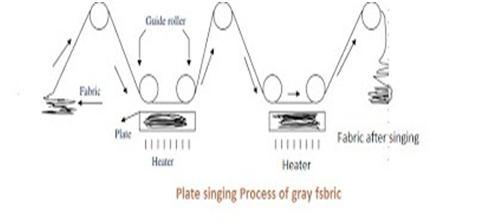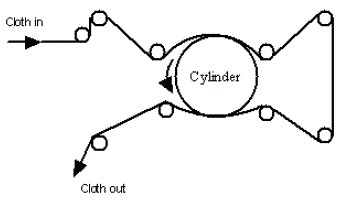SINGING
Singing removes all protruding small hairs from the surface of the fabric and improves the leisters of the fabric.
Objects of Singing:
Bearing of the loose hair of fiber protruding from the surface of the cloth to impart a smooth even and clean looking face.
Why the fabric should be singed?
The fabric which are undergoing mercerizing and printing must be singed.
- The fabrics to be mercerized are singe to be development luster in the fabric.
- In order to impart a clearly define and sharp design the cloth in printing the goods must be singed. Therefore singing may be considered, important and essential process from the point of view of mercerizing and printing.
Type of yarn to be singed:
- Combed cotton yarns.
- High twisted voil threads.
- Sewing threads.
- Polyester cotton blended yarns.
- Hosiery yarns meant for knitting.
Type of fabric to be singed:
Shirting’s, sheeting, sarees dress materials, voil cloths poplins, polyester, and cotton blended fabric.
There are three types of singing.
- Plate singing.
- Roller singing.
- Gas singing.
Plate singing (Procedure):
Plate singing machine essentially consists of two cured plates 1-2” thick and slightly barreled which may be set in the fiber and heated to bright redness by a freeness below or b a suitable heating arrangement of gas and air provision is made for longitudinal expansion of the plate. The hot plate at a speed between 135-125m/min. The protruding fibers are burnt during the passage of cloth through the machine.
Drawbacks:
1) Plate during singing cools down due to the constant content with the cloth which is at lower temperature that the plate.
2) Fibers present in the inter stitches of warp and weft are not singed.
3) Due to the constant contact with the CU plate unnecessary lecture is produced.
4) Main objection of the machine is differently to maintain uniform temp. at middle of the plate by continuous running of cloth resulting uneven singing.
Roller Singing:
In this machine the singing surface is a rotating cylinder instead of stationary curved plate. It may be made of either cut cast iron and provided with internal firing system. The fresh hot surface of the cylinder is presented to the cylinder fabric by the slow rotation of the cylinder. The rotation of the cylinder is in the opposite direction of the fabric movement which rises nap ensuring efficient singing.
Demerits:
1) Unnecessary lecture is produced on the fabric due to the constant content.
2) Both roller and plate singing machine produce minor groves on the metal surface by the continuous run of cloth through the machine.
3) Cloth singed in roller singing after dyeing the selvage are found to dye deeper that the body of the cloth.
Gas Singing Machine:
This machine essentially consists of one or more burner given continuous flat or vertical flames produced by a mixture of compressed air and coal gas. The flames issues from a narrow if which is adjustable width and thickness. When the cloth is drawn over the flame at a high sped the flame impinges on its surface and burns protruding fiber without damaging the cloth. The singing machine has to be adjusted to suit the amount of singing required without the risk of burning the cloth.
When the flame impinges on the cloth surface the fiber ends present in the interstices of the warp and weft are also singed.
Advantages:
1) Both sides are singed at a time.
2) Uniform singing of cloth is obtained.
3) No question of unpatented lecture as there is no contact with any metal surface.
4) Fibers in the interstices are burnt.
5) Speed is as high as 80-125min/min.
6) Flame can be controlled according to the width of the cloth.
7) Different variety of cloth can be signed.
Disadvantages:
1) There is a chance of fiber on the cloth, if the flame is not controlled perfectly.
2) Quench box is necessary after singing to remove burnt fiber.
Precaution in gas machine:
1) The supply of gas to the burner is automatically controlled. If there is breakage of fabric.
2) The machine is enclosed with hood and exhausts for otherwise dust, fly are affecting the eyes.
Singing efficiency:
D= Dia of yarn before singing with protruding ends.
d= Dia of yarn after singing with small protruding ends.
N = d/D*100
The singing of synthetic materials should be done after all wet processing treatment scouring, bleaching, dyeing etc, because the synthetic fiber are produce uneven singing.
Object of Singeing:
The fabric which are undergoing mercerizing and printing must be signed.
- The fabrics to be mercerized are singe to be developing maximum lusture in the fabric.
- In order to impart a clearly define and sharp design to fabric in printing the goods must be singed.
- To remove hairness or protruding fiber from fabric the fabric must singed.
Types of fabric to be singed: Shirting, suiting, sarees, dress materials fabric, voil fabric, poplins, sheeting fabric , cambric fabric, polyester cotton blend fabric should be singed.
Note: The singing of synthetic materials should b done after all wet processing treatments because the synthetic fabric produced uneven singing.




